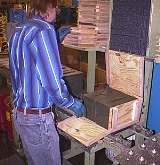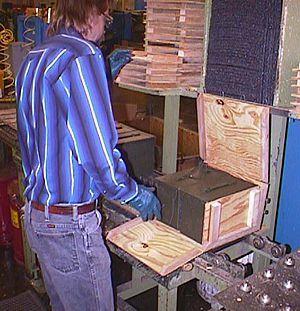
Lake City Army Ammunition Plant
Encyclopedia

Independence, Missouri
Independence is the fourth largest city in the U.S. state of Missouri, and is contained within the counties of Jackson and Clay. It is part of the Kansas City Metropolitan Area...
that was established by Remington Arms
Remington Arms
Remington Arms Company, Inc. was founded in 1816 by Eliphalet Remington in Ilion, New York, as E. Remington and Sons. It is the oldest company in the United States which still makes its original product, and is the oldest continuously operating manufacturer in North America. It is the only U.S....
in 1941 to manufacture and test small caliber ammunition for the U.S. Army. The facility has remained in continuous operation except for one 5-year period following World War II
World War II
World War II, or the Second World War , was a global conflict lasting from 1939 to 1945, involving most of the world's nations—including all of the great powers—eventually forming two opposing military alliances: the Allies and the Axis...
. As of July 2007, the plant produced nearly 1.4 billion rounds of ammunition per year.
Remington Arms operated the plant from its inception until 1985, when operations were taken over by Olin Corporation. Since April 2001, it has been operated by Alliant Techsystems
Alliant Techsystems
Alliant Techsystems Inc., most commonly known by its ticker symbol, ', is one of the largest aerospace and defense companies in the United States with more than 18,000 employees in 22 states, Puerto Rico and internationally, and 2010 revenues in excess of an estimated...
(ATK). LCAAP is the single largest producer of small arms
Small arms
Small arms is a term of art used by armed forces to denote infantry weapons an individual soldier may carry. The description is usually limited to revolvers, pistols, submachine guns, carbines, assault rifles, battle rifles, multiple barrel firearms, sniper rifles, squad automatic weapons, light...
ammunition for the United States military
Military of the United States
The United States Armed Forces are the military forces of the United States. They consist of the Army, Navy, Marine Corps, Air Force, and Coast Guard.The United States has a strong tradition of civilian control of the military...
.
Capabilities
Capabilities of the plant include: Small arms cartridges; components such as percussion and electric primer; pyrotechnics; small caliber ammunition (5.56 mm; 7.62 mm; .50 caliber and 20 mm); performs reliability testing of small caliber ammunition (5.56 mm; 7.62 mm; 9 mm, .22 caliber; .45 caliber and .50 caliber); demilitarization and disposal of small caliber ammunition and explosives. Information Provided by the Joint Munitions CommandHistory
LCAAP was established in December 1940, with production beginning in 1941. It was the first of 12 small arms plants run by the Army. Information Provided by the Joint Munitions CommandFacilities
LCAAP is housed on 3935 acres (15.9 km²) with 458 buildings, 40 igloos and storage capacity of 707000 square feet (65,682.4 m²). Information Provided by the Joint Munitions CommandEnvironment
LCAAP was placed on the Environmental Protection Agency’s National Priority List(Superfund) in 1987. Information Provided by the Joint Munitions Command
Hazardous waste contamination
Historically, LCAAP waste treatment and disposal occurred on-site and relied on unlined lagoons, landfillLandfill
A landfill site , is a site for the disposal of waste materials by burial and is the oldest form of waste treatment...
s, and burn pits. The plant generated large quantities of potentially hazardous wastes and hazardous substances, including solvents, oils, greases, explosives, radionuclide
Radionuclide
A radionuclide is an atom with an unstable nucleus, which is a nucleus characterized by excess energy available to be imparted either to a newly created radiation particle within the nucleus or to an atomic electron. The radionuclide, in this process, undergoes radioactive decay, and emits gamma...
s, perchlorates, and heavy metals. As a result of the extensive contamination, the site has been named to the United States Environmental Protection Agency
United States Environmental Protection Agency
The U.S. Environmental Protection Agency is an agency of the federal government of the United States charged with protecting human health and the environment, by writing and enforcing regulations based on laws passed by Congress...
's National Priorities List.
External links
- Joint Munitions Command website
- Information compiled from http://www.jmc.army.mil/FactSheets/FactSheets%202008/Lake%20City%20Army%20Ammunition%20Plant.pdf

